The "Miracle on Ice" was a triumph of belief and inspiration over discipline and experience against the backdrop of the Cold War and its spillover into sports, specifically the Olympics. It happened on Feb. 22, 1980.
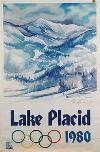
The Summer Olympic Games in 1980 were in Moscow. Earlier in the year, as the Winter Games were set to begin, the United States had announced that, in protest against the Soviet Union's war against Afghanistan, it would boycott the Moscow Games in July and August. This was a time when the Winter Olympics still took place in the same year as the Summer Olympics; in 1980, the Winter Games were in the United States, in the New York town of Lake Placid.
Ice hockey was a particularly strong discipline of the Soviet team. They had first participated in 1956 and had won gold in the event in 1964 and in 1968 and in 1972 and in 1976; in fact, the Soviet team had not lost a game in the Olympics at all since 1968.
The American team had had relatively meager success by contrast, placing fifth in 1964, sixth in 1968, and fifth in 1976. The U.S. team had defeated the Soviet Union en route to the gold medal in 1960 and had then secured the silver in 1972.
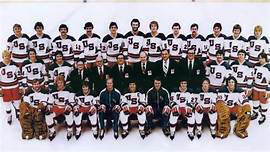
The American-Soviet matchup was, on paper, a mismatch, most observers believed. Olympic rules at the time prohibited professional athletes from participating, but most of the Soviet team had extensive experience at the international level; by contrast, most of the American players were current or former players for Herb Brooks, the coach at the University of Minnesota, or from Boston University. Both colleges were hockey powerhouses, and many of these players went on to play in the National Hockey League; but in 1980, the American team was young, the youngest in the country's history. They had trained together extensively by the time the Olympics began, but they were still young.
In 1980, the U.S. team went undefeated in the first round (including a 7–3 victory over powerful Czechoslovakia), although they did tie with Sweden, the Blue Division's other undefeated team. (Significantly, in that game, Brooks pulled his goalie late in the game and substituted another attacker; the result was a last-minute goal that secured the tie.) Both teams qualified for the medal round. In the Red Division, Finland won a tiebreaker against Canada to qualify for the medal round; the Soviet team, meanwhile, went undefeated, scoring 51 goals and allowing 11. The U.S. team had scored 26 goals in their five games and allowed 10.
The format for determining the medals was not a shootout, as it is now. Each team from a division had to play both teams from the other division. For the first games, Sweden played Finland and the U.S. faced off against the Soviet Union.
The American team had won four games in the first round and had played Sweden to a 2–tie, but they were young (average age 22), and their team captain, Mike Eruzione, came from the International League, a minor professional league. The goalie's name was Jim Craig.
In an exhibition game three days before the Lake Placid Games began, the U.S. and the U.S.S.R. played an exhibition game at Madison Square Garden in New York City; the Soviets won that game 10–3.
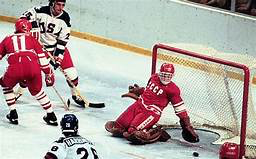
A crowd of 8,500 was jammed into the hockey arena on Feb. 22, 1980. The Soviets struck first in the first period, behind a slap shot from Valery Krotov. The Americans countered not long after, when a high 50-foot shot from Buzz Schneider (the only previous Olympians on the U.S. team) cleared the grasp of Soviet goalie Vladislav Tretiak, who was considered the best goalie in the game.
In what was a frenzied period, both teams scored another goal. Sergei Makarov's goal gave the Soviets a brief 2– lead, but Mark Johnson's equalizer with one second left tied the score again.
The Soviet team changed goalies for the second period, designating Vladimir Myshkin to defend their goal. They also turned up the attack. They scored two minutes in, on a goal by Alesandr Maltsev. In the second period, the Soviets had 12 shots on goal and would have scored more if not for the inspired play of Jim Craig, the U.S. goalie.
As the final 20-minute period began, the Soviets held a 3–2 lead. Nine minutes in, American Mark Johnson, who had set up Schneider's goal at the end of the first period, scored one himself, taking a wild shot from teammate David Silk and sending it into the Soviet net.
The score was tied, 3–3.
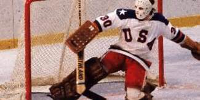
Not less than two minutes after Johnson's goal, Eruzione got hold of a loose puck and sent off a shot from 25 feet away that got past the Soviet goalie. America led, 4–3.
Ten minutes remained, however, and the Soviet pressure was relentless. Craig was up to the task, however, saving goal after goal. (He saved 36 in the game and 163 overall.) One Soviet shot ricocheted off the right goalpost but did not go in.
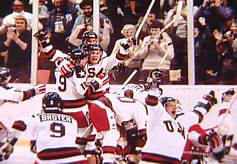
Time expired with the U.S. in the lead. The young yet talented American team had defeated the mighty Soviet juggernaut, handing it its first Olympic hockey defeat in 32 years.
It was called the "Miracle on Ice," after television broadcaster Al Michaels ended the game saying, "Do you believe in miracles? Yes!"
That was just the first game, however. Coach Herb Brooks had to get his team psyched up for the next game, against Finland.
Sweden and Finland played to a 3–3 tie in their first medal round game. In the Finland-U.S. game, Finland scored first and led 2–1 going into the final period. The U.S. team found their momentum and scored three goals for another come-from-behind victory, this one by the final score of 4–2.
The American team had gone undefeated in the medal round and won gold. Taking silver was the Soviet Union, which took out its frustration on Sweden in the final game, winning 9–2.
In the medal round, teams carried over results from the previous round if those results had come against a time that had made the medal round. So the 2–2 tie between Sweden and the U.S. was significant for Sweden because in the previous round in the Red Division, the Soviet Union had defeated Finalnd 4–2. So even though Sweden and Finland had played to a tie in the medal round, it was the Finnish loss to the Soviets compared to the Swedish tie with the Americans that gave the bronze medal to Sweden.